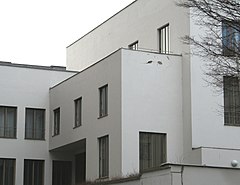Wittgenstein House
| Haus Wittgenstein | |
|---|---|
 |
|
| Alternative names | Stonborough House, Wittgenstein House |
| General information | |
| Architectural style | Modernist |
| Address | Kundmanngasse |
| Town or city | Vienna |
| Country | Austria |
| Coordinates | 48°12'12.0"N 16°23'39.0"E |
| Current tenants | Bulgarian Embassy |
| Opened | 25 December 1928 |
| Client | Margaret Stonborough-Wittgenstein |
| Design and construction | |
| Architect | Paul Engelmann |
Haus Wittgenstein, (also known as the Stonborough House and the Wittgenstein House) is a house in the modernist style on the Kundmanngasse, Vienna, Austria. The house was commissioned by Margaret Stonborough-Wittgenstein, who asked the architect Paul Engelmann to design a townhouse for her. Stonborough-Wittgenstein invited her brother, the philosopher Ludwig Wittgenstein, to help with the design.
In November 1925 Stonborough-Wittgenstein commissioned Engelmann to design a large townhouse. She later invited her brother, Ludwig Wittgenstein, to help with the design, in part to distract him from the scandal surrounding the Haidbauer incident in April 1926: Wittgenstein, while working as a primary-school teacher, had hit a boy who had subsequently collapsed.
The initial architect was Paul Engelmann, someone Wittgenstein had come to know while training to be an artillery officer in Olomouc. Engelmann designed a spare modernist house after the style of Adolf Loos: three rectangular blocks. Wittgenstein showed a great interest in the project and in Engelmann's plans and poured himself into the project for over two years, to such a degree that Engelmann himself considered Wittgenstein the author of the final product. During this period, Wittgenstein is listed in the Vienna city directory as: Leudwig Wittgenstein, Architect. He focused on the windows, doors, door knobs, and radiators, demanding that every detail be exactly as he specifieid, to the point where everyone involved in the project was exhausted. When the house was nearly finished, he had a ceiling raised 30 mm so that the room had the exact proportions he wanted.
One of the architects, , wrote in a letter: "I come home very depressed with a headache after a day of the worst quarrels, disputes, vexations, and this happens often. Mostly between me and Wittgenstein."
Waugh writes that Margaret eventually refused to pay for the changes Wittgenstein kept demanding, so he bought himself a lottery ticket in the hope of paying for things that way. It took him a year to design the door handles, and another to design the radiators. Each window was covered by a metal screen that weighed 150 kg, moved by a pulley Wittgenstein designed. Bernhard Leitner, author of The Architecture of Ludwig Wittgenstein, said of it that there is barely anything comparable in the history of interior design: "It is as ingenious as it is expensive. A metal curtain that could be lowered into the floor."
...
Wikipedia
